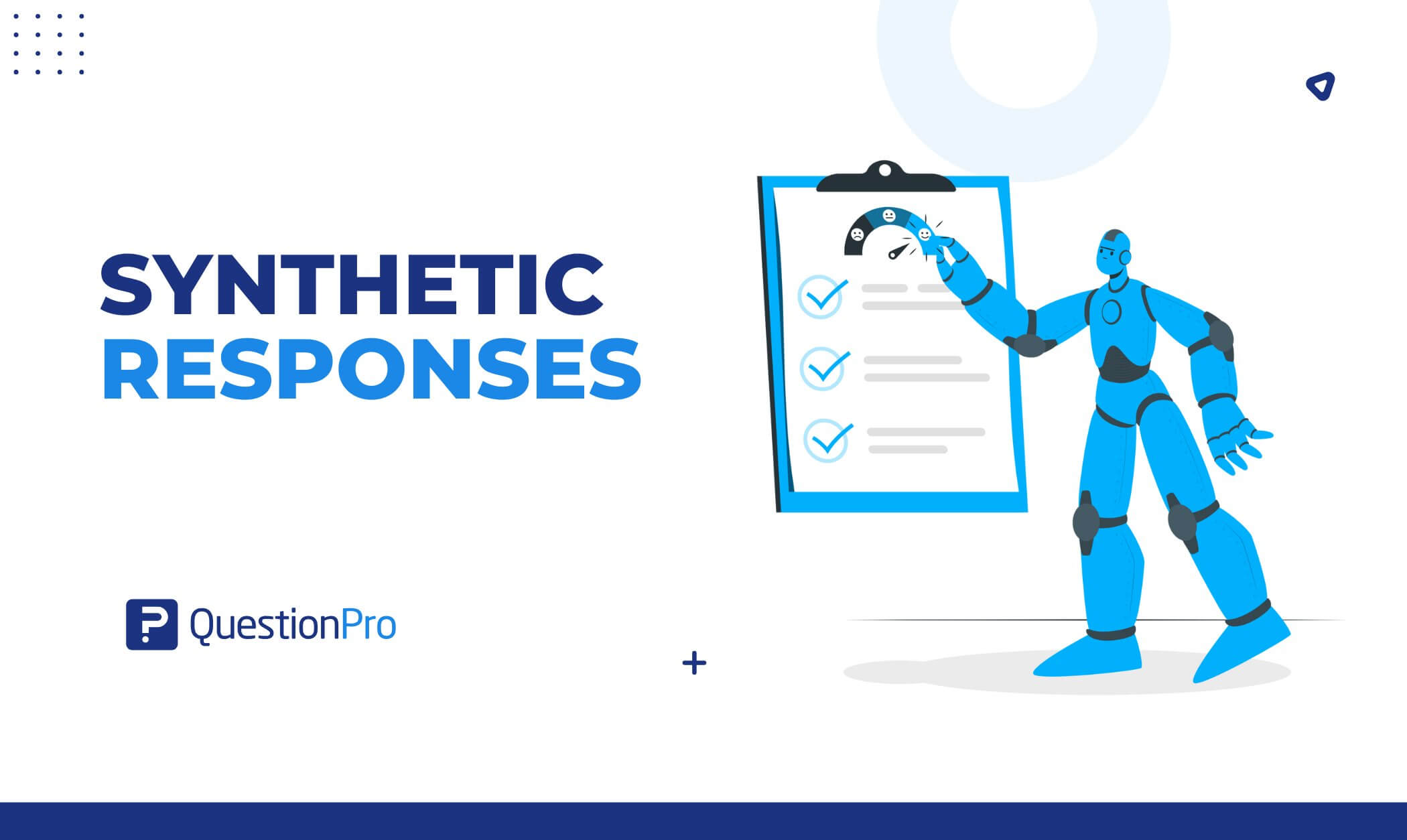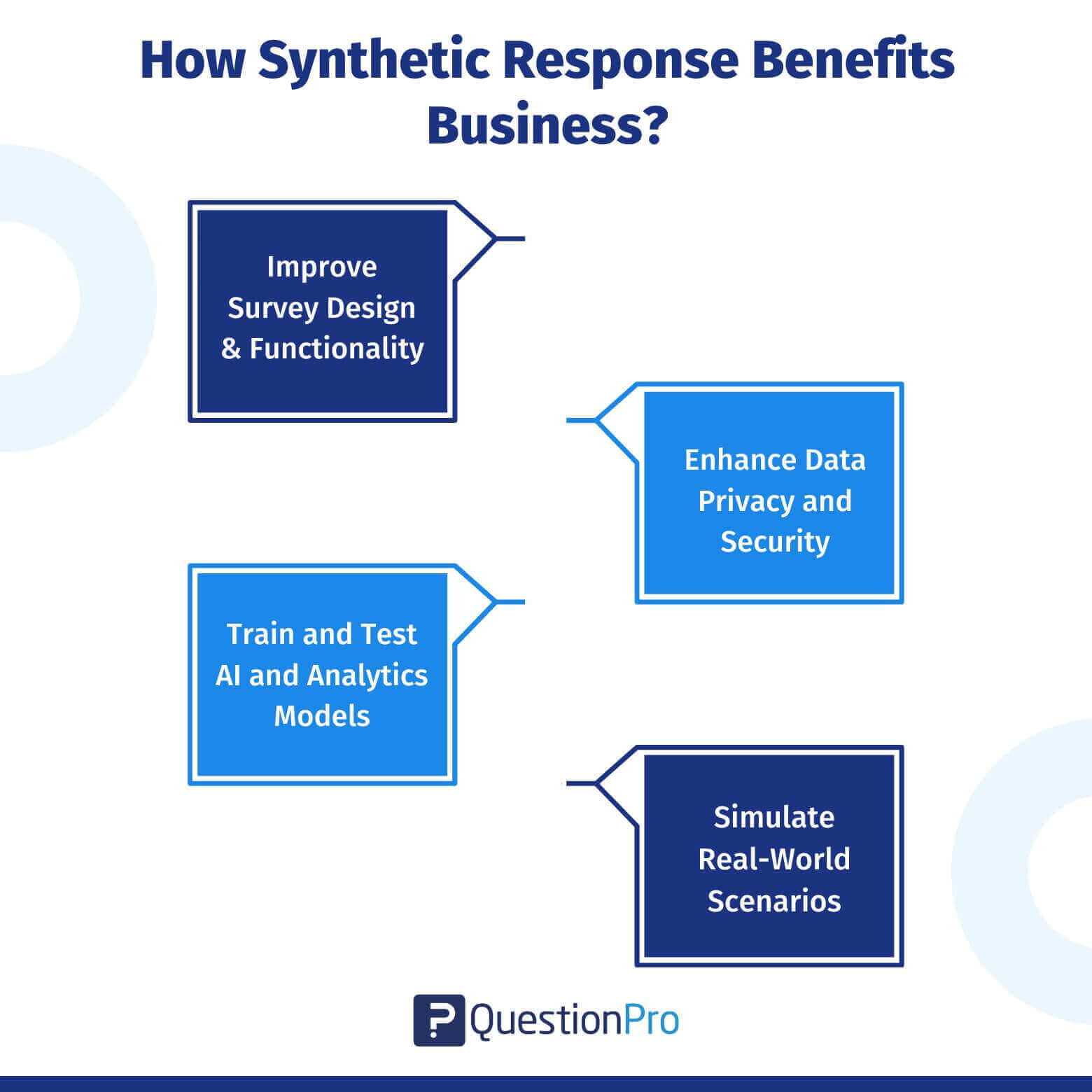
Not all responses come from real people when collecting data for market research, testing, or feedback. Computers create some, and they’re called synthetic responses. These AI-generated replies are designed to look and feel like real ones, but are not based on actual human experiences. So, how do synthetic data responses compare to real ones? What are they used for, and why do they matter?
In this blog, we’ll explain synthetic responses in market research, how they work, why they’re helpful, and how they compare to real responses. Whether in research, tech, or just curious, this guide will help you understand the differences clearly and simply.
What are Synthetic Responses?
Synthetic responses are artificially generated data points that mimic real human reactions.
Instead of coming from actual people, these responses are generated using computer programs, algorithms, or AI models. They are designed to look and feel like real answers from synthetic respondents, a chatbot, or synthetic datasets.
Think of it like you’re testing a new survey, but you don’t have real people to answer it yet. Instead of waiting for real responses, you can use synthetic responses to see how your survey performs. These artificial answers help identify errors, test logic, and preview what the final results might look like without human input immediately.
These responses are often used in:
- Market research industry
- AI training
- Software testing, and
- Privacy-sensitive projects, where using real data isn’t possible or safe.
Even though they’re not from real people, these responses are created to be realistic, often by learning patterns from real-world data and replicating them securely, non-identifiably.
Synthetic responses are fake but thoughtful answers that help us test systems, protect privacy, and work faster, especially when actual data collection is challenging or risky.
How Synthetic Responses Benefit Business?
Synthetic responses and artificially generated survey answers offer significant advantages for both business and the market research industry. Here’s how they deliver value:

1. Improve Survey Design & Functionality
Businesses and researchers use synthetic responses to test surveys before launch. This helps:
- Identify logic errors or skip pattern issues.
- Validate conditional routing and dynamic content.
- Ensure proper data collection across question types.
This early testing reduces errors that could affect data quality later on.
2. Enhance Data Privacy and Security
When sharing or analyzing sensitive survey data (e.g., employee feedback or patient information), synthetic responses can replace real data to:
- Avoid exposing personally identifiable information (PII).
- Enable safe third-party testing or demonstrations.
- Support compliance with data privacy regulations like GDPR or HIPAA.
3. Train and Test AI and Analytics Models
Synthetic data can be used to train machine learning models to:
- Detect fraudulent responses or bots.
- Predict customer sentiment or churn based on response patterns.
- Automate text classification for open-ended survey comments.
This allows teams to build smarter, data-driven tools without over-reliance on real-world data.
4. Simulate Real-World Scenarios
Researchers can model situations using fake responses to forecast how respondents might react to changes (e.g., new product features or pricing). They understand bias or response trends across demographic segments. It helps to estimate the effect of incomplete data or survey fatigue.
How to Create Synthetic Responses?
Artificial responses might sound complex, but their idea is pretty simple: they’re fake responses made to act like real ones. The goal is to create synthetic data that looks and feels real, without involving actual people.
Here’s how they usually work, step by step:
1. Start with Real Data (or Patterns)
To create believable synthetic responses, a system usually starts by studying real responses, like:
- Answers from surveys
- Customer chats or
- Online reviews
It looks for patterns in how people typically respond.
2. Use AI or Algorithms to Create New Responses
Once it understands the patterns, an AI model or algorithm generates new responses that follow the same style. These responses are new; they don’t copy real answers word-for-word, but they sound like something a real person might say.
For example, if most people say “I love the fast delivery” in a product review, the synthetic response might say “Quick shipping was a big plus!” with a similar feeling, but different words.
3. Test for Realism and Quality
Good synthetic responses should be realistic. That means they need to sound natural, follow the same trends as real answers, and fit the context. Developers often test these responses to make sure they make sense and don’t sound robotic or random.
4. Use Them for Research, Testing, or Training
Once they’re ready, the fake responses are used for all sorts of tasks, from testing a survey or website to training a chatbot or AI model. They let teams try things out without waiting for real people to respond.
In simple terms, these artificial responses are smart guesses created by machines based on real consumer behavior. They help us build, test, and learn faster while protecting privacy and saving time.
Challenges and Limitations of Synthetic Responses
While synthetic responses are helpful in market research, they’re not perfect. Here are some key challenges:
- Not 100% Accurate: They’re based on patterns, not real thoughts, so they may miss real-world behaviors.
- Lack of Human Emotion: Synthetic replies can sound real, but don’t reflect true feelings or intentions.
- Can Be Biased: If the original data has bias, the synthetic feedback might repeat or worsen it.
- Not a Full Replacement: They’re great for testing, but shouldn’t replace real human feedback.
- Ethical Concerns: Using synthetic feedback without being transparent can create trust issues.
How QuestionPro Helps in Generating Synthetic Responses?
QuestionPro makes it easier for researchers and organizations to test surveys and collect data quickly, even before reaching real people. One helpful feature it offers is the ability to generate synthetic responses.
This means you can create sample responses using the platform’s built-in tools. These aren’t real answers from real people, but computer-generated responses that simulate how someone might answer your survey. It’s a great way to:
- Test how your survey looks and flows
- Check if the logic and question branching work properly
- See how your data will appear in reports and dashboards
QuestionPro allows you to auto-generate a set number of sample responses with just a few clicks. This is super helpful when you’re still designing your survey and want to make sure everything is working correctly, without waiting for real responses.
QuestionPro gives you a simple and fast way to generate synthetic responses, so you can save time, fix issues early, and launch a smoother, more reliable survey for your market research.
Conclusion
We’ve learned how synthetic responses work, where they shine, and how they compare with real responses. Hopefully, you now have a better understanding of when and why to use each.
Synthetic feedback can save you time and resources if you’re building a system, testing a survey, or training a model. But if you’re after valuable insights, the kind that shape real decisions, don’t skip out on collecting real responses. Ultimately, human responses remain the most beneficial.
If you’re looking for a simple way to generate synthetic responses and test your surveys before launching, QuestionPro makes it easy. With just a few clicks, you can create sample data to check your survey flow, logic, and reports, helping you build a better experience from the start.
Frequently Asked Questions (FAQs)
Answer: They save time and money by allowing businesses and researchers to test survey logic, system performance, or data models before collecting real responses.
Answer: Use synthetic responses when testing a survey, training a system, or checking how your reporting looks. They’re ideal in the early stages of development.
Answer: They can mimic the structure of real responses, but they don’t carry actual human thoughts or feelings. They’re more about function than meaning.
Answer: Many survey tools like QuestionPro offer built-in features to generate synthetic or test responses automatically.
Answer: Absolutely. Synthetic responses are often used to train machine learning models when real data is limited or unavailable.







